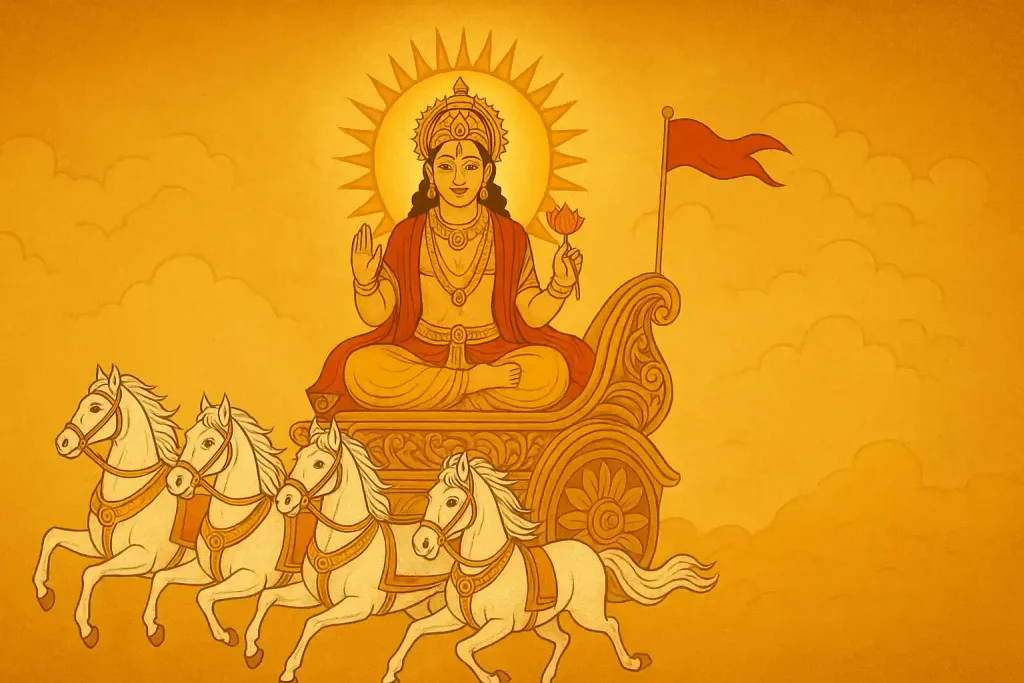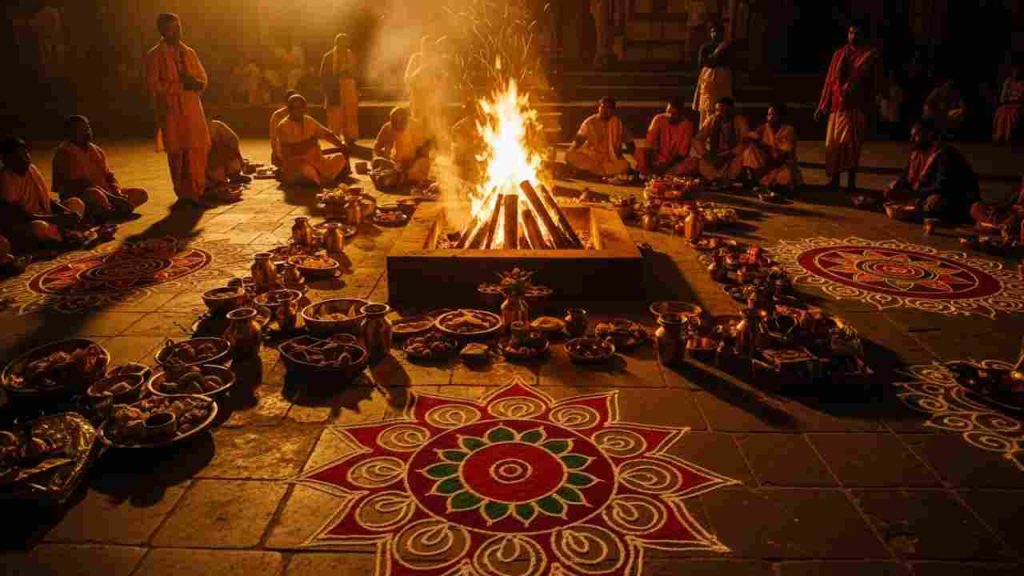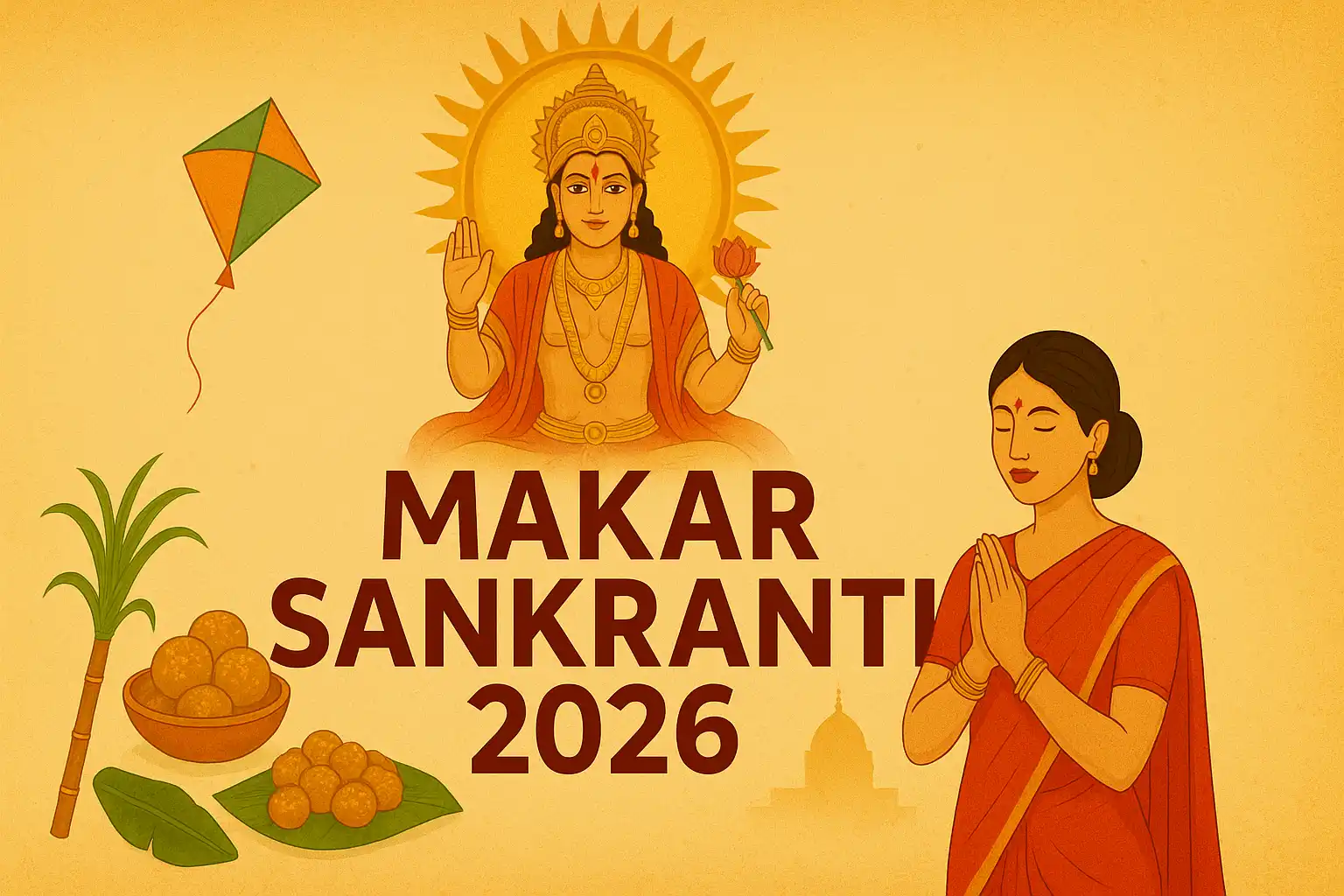Every year in mid-January, when winter begins to loosen its grip and the skies start to glow brighter, India welcomes one of its most sacred and widely celebrated festivals — Makar Sankranti. In 2026, this festival will be celebrated with the same divine enthusiasm, marking the transition of the Sun into the zodiac sign of Capricorn (Makara Rashi).
But beyond the astronomical event lies a spiritual and mythological essence — the journey of Surya Dev (the Sun God), the victory of light over darkness, and the message of gratitude, renewal, and harmony with nature.
Let us explore in depth the story, traditions, and cosmic meaning of Makar Sankranti 2026, and how this ancient celebration continues to guide modern life.
What is Makar Sankranti?
The word “Makar” means Capricorn, and “Sankranti” means transition or movement. Together, Makar Sankranti marks the Sun’s movement into the zodiac sign of Capricorn, which signals the beginning of Uttarayana, or the Sun’s northward journey.
This day is considered highly auspicious because it symbolizes the end of winter and the start of longer, warmer days. In spiritual terms, it represents enlightenment, progress, and self-purification — as the light of Surya Dev begins to grow stronger each day.
Unlike other Hindu festivals that follow the lunar calendar, Makar Sankranti is based on the solar cycle, which is why it usually falls on January 14 every year (occasionally January 15).
In 2026, Makar Sankranti will be celebrated on 14 January 2026.
The Astronomical & Astrological Significance
Makar Sankranti is more than a harvest celebration — it’s a celestial milestone. It marks the sun’s shift from Dakshinayana (southward movement) to Uttarayana (northward movement).
-
🌞 End of Dakshinayana: The period when the sun’s rays lean towards the southern hemisphere, symbolizing rest and introspection.
-
🌅 Beginning of Uttarayana: The sun starts moving northward, bringing longer days, vitality, and renewed energy — both physically and spiritually.In astrology, this is also the day when Surya Dev enters Capricorn (Makara Rashi), ruled by Shani Dev (Saturn). This union of the Sun and Saturn — father and son — carries deep mythological symbolism about forgiveness and balance.
The Story of Surya Dev and Makar Sankranti
Who is Surya Dev?
Surya Dev, the radiant Sun God, is one of the oldest and most powerful deities in Hindu mythology. He is considered the source of life, light, and consciousness.
In scriptures, Surya Dev is described as riding a golden chariot pulled by seven horses, representing the seven colors of sunlight and the seven days of the week. He embodies energy, clarity, discipline, and truth.

The Mythological Connection with Makar Sankranti
There are several stories linking Surya Dev to Makar Sankranti. The most well-known is the reconciliation of Surya Dev and his son, Shani Dev.
According to the Puranas:
-
Shani Dev, the god of justice, rules over the zodiac sign Capricorn (Makara).
-
Despite being father and son, their relationship was strained due to misunderstandings.
-
On the day of Makar Sankranti, Surya Dev visits Shani Dev’s home — symbolizing forgiveness, understanding, and unity.
This act of reconciliation teaches us an important life lesson: no matter how strained a relationship may be, love and light can heal all bonds.
Surya Dev and His Spiritual Symbolism
Surya Dev represents truth, energy, and the guiding light of consciousness. He is not merely the physical sun but the spiritual energy that sustains the universe.
Symbolically, his journey across the zodiac mirrors our own inner journey of growth — moving from darkness (ignorance) to light (knowledge).
Worshiping Surya Dev during Makar Sankranti is believed to:
-
Bring vitality and strength
-
Purify the mind and body
-
Remove obstacles
-
Enhance focus, success, and health
Many devotees chant the Gayatri Mantra or Surya Mantra during sunrise to absorb the positive vibrations of the Sun.
Makar Sankranti as a Harvest Festival
While the festival has astronomical roots, it is also deeply tied to India’s agricultural traditions. Makar Sankranti marks the end of the winter harvest season — a time to thank the Sun, Earth, and nature for abundance.
Across the country, farmers celebrate their hard work and express gratitude for the harvest. It is also the time when communities come together to share food, joy, and prosperity.
Common harvest themes across India:
-
Thanksgiving to nature and cattle for their contribution
-
Bonfires and feasts marking the end of winter
-
Flying kites symbolizing freedom, hope, and aspiration
Regional Celebrations Across India
Though Makar Sankranti is celebrated all over India, each region has its own name, flavor, and customs:
1. Uttarayan (Gujarat and Rajasthan)
The skies come alive with colorful kites! People celebrate the International Kite Festival in Ahmedabad, signifying joy, competition, and the welcoming of the Sun.
2. Pongal (Tamil Nadu)
A four-day harvest festival where the new crop is cooked as Pongal — a mixture of rice, milk, and jaggery — symbolizing prosperity and gratitude to Surya Dev.
3. Lohri (Punjab and Haryana)
Celebrated the night before Sankranti with bonfires, dancing, and singing. People offer sesame, jaggery, and popcorn to the fire as a token of gratitude.
4. Khichdi Sankranti (Uttar Pradesh and Bihar)
People take holy dips in the Ganga and offer khichdi (a rice-lentil dish) to the poor, seeking blessings from Surya Dev.
5. Magh Bihu (Assam)
Farmers rejoice after the harvest season with feasts, music, and community bonding.
6. Makara Vilakku (Kerala)
At the famous Sabarimala Temple, devotees witness the sacred light “Makara Jyothi,” which appears on this day, marking the divine union of energy and devotion.
Each variation emphasizes the same universal theme — gratitude, light, and transformation.
Traditional Foods & Their Symbolism
Every festival in India has its signature dishes — and Makar Sankranti is no exception.
Key Traditional Delicacies:
-
Til-Gur Laddoo: Made of sesame and jaggery, symbolizing warmth, unity, and the sweetness of relationships.
-
Pongal / Khichdi: Signifies simplicity, nourishment, and balance.
-
Puran Poli & Gajak: Represent prosperity and the sharing of happiness.
In Maharashtra, people greet each other saying, “Tilgul ghya, god god bola” — meaning “Accept this sweet and speak sweetly.”
It reminds everyone to let go of bitterness and spread kindness.
Spiritual Practices on Makar Sankranti
1. Surya Arghya (Offering to the Sun)
At sunrise, devotees offer water to the rising Sun while chanting:
“Om Suryaaya Namah”
This simple act purifies the mind and invites divine energy.
2. Holy Dips in Rivers
Taking a bath in sacred rivers such as the Ganga, Yamuna, or Godavari is believed to cleanse sins and bring spiritual merit.
3. Charity and Seva (Service)
Giving food, clothes, or donations on this day amplifies positive karma, symbolizing selflessness — a quality associated with Surya Dev.
4. Fasting and Meditation
Many observe fasts or spend time in meditation, focusing on inner purification and gratitude.
The Deeper Symbolism: Light, Energy, and Renewal
Makar Sankranti teaches profound lessons beyond rituals:
-
Light over Darkness: Just as the Sun begins its northward climb, we are reminded to rise above ignorance and negativity.
-
Forgiveness and Harmony: The story of Surya Dev and Shani Dev encourages letting go of grudges.
-
Gratitude and Giving: Sharing sweets and helping others is symbolic of spreading warmth in society.
-
Self-Transformation: Like the changing position of the Sun, change in life is constant — and embracing it leads to growth.
Makar Sankranti 2026: Muhurat and Date Details
-
Festival Date: Wednesday, January 14, 2026
-
Punya Kaal (Auspicious Period): 7:15 AM – 12:30 PM (approx.)
-
Maha Punya Kaal: 7:15 AM – 9:00 AM
(Note: Timings may slightly vary based on location.)
This period is considered most auspicious for offering prayers and performing Surya Arghya.
Modern Relevance of Makar Sankranti
In today’s busy world, Makar Sankranti holds timeless value. It reminds us to:
-
Pause and reflect: Just like nature shifts cycles, we too must renew our goals and energy.
-
Stay connected: Festivals like Sankranti bring families and communities together.
-
Respect nature: Thanking the Sun and Earth is a gesture of ecological awareness.
By celebrating Makar Sankranti, we align our lives with nature’s rhythm, gratitude, and positivity.
How to Celebrate Makar Sankranti 2026 Meaningfully
-
Wake up before sunrise and offer water to Surya Dev.
-
Chant Surya Mantras — “Om Ghrini Surya Adityaya Namah.”
-
Prepare traditional dishes and share them with family or the needy.
-
Clean your home and prayer space, symbolizing purification.
-
Fly kites or light lamps to celebrate brightness and hope.
-
Spend time outdoors, soaking in the warmth of the Sun.
Each small act of devotion or gratitude amplifies positivity and invites blessings from Surya Dev.
The Spiritual Message of Surya Dev
Surya Dev is not only the giver of light — he represents the inner Sun within all of us. His message for Makar Sankranti 2026 is clear:
“Rise above darkness. Forgive, give, and glow.”
As the Sun moves northward, it calls upon us to move forward — towards growth, knowledge, and harmony.
Conclusion
Makar Sankranti 2026 is more than a festival — it’s a reminder of cosmic balance, gratitude, and new beginnings. It celebrates the eternal journey of Surya Dev — from one zodiac to another, from night to dawn, from ignorance to enlightenment.
As the rays of the Sun grow stronger in January 2026, may we too:
-
Strengthen our spirits
-
Brighten our hearts
-
Forgive old wounds
-
Embrace new opportunities
Let’s celebrate Makar Sankranti 2026 not just by flying kites or sharing sweets, but by honoring the light within and around us.
Happy Makar Sankranti 2026!
May Surya Dev bless you with warmth, energy, and prosperity. 🌞


